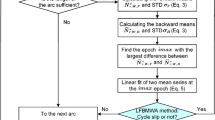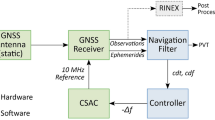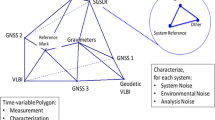Abstract
Autonomous timekeeping is necessary to maintain the navigation system time when the ground operation control system is unavailable. We use Ka-band inter-satellite two-way ranging data from Beidou-3 network satellites to carry out autonomous timekeeping tests. First, we introduce an algorithm for distributed autonomous timekeeping that uses Beidou-3 inter-satellite links and high-performance onboard passive hydrogen masers (PHMs). Using these tools, we analyze the main factors affecting the performance of autonomous timekeeping. Finally, the performance of autonomous timekeeping is evaluated using overall time drift and frequency stability, and this performance is compared with the timekeeping performance using broadcast clock offset parameters. Without autonomous corrections, use of the broadcast parameters will result in non-uniform drifts of satellite clocks versus Beidou system time (BDT) of over 300 ns after 30 days. Using the algorithm we present, the time reference within the constellation can be unified, and the timekeeping performance can be further improved through fine modeling of the satellite clocks. After 30 days of autonomous operation, the overall time drift of the constellation relative to BDT can be less than 1.3 ns (the last epoch), and the frequency stability is about 1.2E−14 at 86,400 s interval.





Similar content being viewed by others
Data availability
The BDS3 ISL measurements and TWSTFT data are available from the corresponding author upon request.
References
Ananda M, Bernstein H, Cunningham K, Feess W, Stroud E (1990) Global positioning system (GPS) autonomous navigation. In: IEEE symposium on position location and navigation symposium A decade of excellence in the navigation sciences. IEEE March 20. https://doi.org/10.1109/PLANS.1990.66220
Bonino L (2015) Application of optical quantum links to GNSS, an ESA study [EB/OL]. http://www.ienit/~brida/Quantum_2012/doc/Bonino.Pdf.
Brinkmann G, Crevals S, Frye J (2013) An independent set approach for the communication network of the GPSIII system. Discrete Appl Math 161(4):573–579
Brown KR (1991) The theory of the GPS composite clock. In: Proceedings of ION GPS 1991. Institute of Navigation, Albuquerque, NM, USA, September 11–13, pp 223–241
Chen JP et al (2020) SIS accuracy and service performance of the BDS-3 basic system. Sci China Phys Mech Astron 63:269511. https://doi.org/10.1007/s11433-019-1468-9
Clark J, Langer J, Powell T (2010) What GPS might have been—and what it could become. Crosslinks 11(1):70–77
Codik A (1985) Autonomous navigation of GPS satellites: a challenge for the future. Navigation 32(3):221–232
D’Angelo P, Fernandez A, Guardabrazo T, Amarillo F (2012) Enhancement of GNSS navigation function by the use of inter-satellite links. In: 2012 6th ESA Workshop on satellite Navigation Technologies and European Workshop on GNSS signals and Signal Processing (NAVITEC). Noordwijk Netherlands: IEEE, pp 1–6
Fernandez FA (2011) Inter-satellite ranging and inter-satellite communication links for enhancing GNSS satellite broadcast navigation data. Adv Space Res 47(5):786–801
Gerlin F, Laurenti N, Naletto G, Giuseppe V, Villoresi P, Bonino L (2013) Design optimization for quantum communications in a GNSS intersatellite network // NavSAS Group, 2013 international conference on localization and GNSS (ICL-GNSS), Turin, Italy. IEEE, pp 1–6
Greenhall CA (2006) A Kalman filter clock ensemble algorithm that admits measurement noise. Metrologia 43:311–321
Greenhall CA (2013) Forming stable timescales from the Jones–Tryon Kalman filter. Metrologia 40:335–341
Guo R, Hu X, Tang B, Huang Y, Liu L, Cheng L, He F (2010) Precise orbit determination for geostationary satellites with multiple tracking techniques. Chin Sci Bull 2010(55):687–692.
Han CH, Cai ZW, Lin YT, Liu L, Xiao SH, Zhu LF (2013) Int J Navig Obs 2013:371450
Jones RH, Tryon PV (1983) Estimating time from atomic clocks. J Res Natl Bureau Stand 88(1):17
Liang H, Gao GX, Walter T, Enge P (2011) Statistical characterization of GLONASS broadcast ephemeris errors. In: Proceedings of ION ITM 2011. Institute of Navigation, San Diego, CA, USA, January 24–26, pp 3109–3117
Liu L, Zhu L, Han C, Liu X, Li C (2009) The model of radio two-way time comparison between satellite and station and experimental analysis. Chin Astron Astrophys 33(4):431–439
Maine KP, Anderson P, Langer J (2003) Crosslinks for the next-generation GPS. In: IEEE aerospace conference, pp 1589–1596
Menn M (1986) Autonomous navigation for GPS via crosslink ranging. In: PLANS '86—position location and navigation symposium. IEEE, New York, pp 143–146
Pan J, Hu X, Zhou S, Tang C, Guo R, Zhu L, Tang G, Hu G (2018) Time synchronization of new-generation BDS satellites using inter-satellite link measurements. Adv Space Res 61(1):145–153
Pan J, Hu X, Zhou S, Tang C, Wang D, Yang Y, Dong W (2021) Full-ISL clock offset estimation and prediction algorithm for BDS3. GPS Solut 25:140. https://doi.org/10.1007/s10291-021-01177-0
Panfilo G, Arias EF (2010a) Algorithms for international atomic time. IEEE Trans Ultrason Ferroelectric Freq Control 55(1):140–150
Panfilo G, Arias EF (2010b) Studies and possible improvements on the EAL algorithm. IEEE Trans Ultrason Ferroelectric Freq Control 57:154–160
Panfilo G, Harmegnies A, Laurent T (2012) A new prediction algorithm for the generation of international atomic time. Metrologia 49:49–56
Parker TE, Levine J (1997) Impact of new high stability frequency standards on the performance of the NIST AT1 time scale. IEEE Trans Ultrason Ferroelectr Frequency Control 44(6):1239–1244
Sanchez M, Pulido JA, Amarillo F, Gerner JL (2008) Inter-satellite ranging and communication links in the frame of the GNSS infrastructure evolutions. In: Proceedings of ION GNSS 2008. Institute of Navigation, Savannah, GA, USA, September 16–19, pp 2583–2546
Steigenberger P, Montenbruck O (2017) Galileo status: orbits, clocks, and positioning. GPS Solut 21(2):319–331. https://doi.org/10.1007/s10291-016-0566-5
Suess M, Greenhall CA (2012) Combined covariance reductions for Kalman filter composite clocks. Metrologia 49:588–596
Tang C et al (2018) Initial results of centralized autonomous orbit determination of the new-generation BDS satellites with inter-satellite link measurements. J Geodesy 92(10):1155–1169
Weiss M, Weissert T (1991) AT2, a new time scale algorithm: AT1 plus frequency variance. Metrologia 28:65–74
Weiss MA, Allan DW, Peppler TK (1989) A study of the NBS time scale algorithm. IEEE Trans Instrum Meas 38:631–635
Wu Z et al (2018) Performance of the BDS3 experimental satellite passive hydrogen maser. GPS Solut 22:43
Xie X, Geng T, Zhao QL, Cai HL, Zhang F, Wang X, Meng YN (2019) Precise orbit determination for BDS-3 satellites using satellite-ground and inter-satellite link observations. GPS Solut 23(2):40
Yang YF, Yang YX, Hu XG, Chen JP, Guo R, Tang CP, Zhou SS, Zhao LQ, Xu JY (2020) Inter-satellite link enhanced orbit determination for BeiDou-3. J Navig 73(1):115–130
Zhou W, Cai H, Li Z, Tang C, Hu X, Liu W (2022) Research on the rotational correction of distributed autonomous orbit determination in the satellite navigation constellation. Remote Sens 14(14):3309. https://doi.org/10.3390/rs14143309
Acknowledgements
This work was supported by the National Natural Science Foundation of China (Grant Nos. 12173072, 41974041).
Author information
Authors and Affiliations
Corresponding author
Additional information
Publisher's Note
Springer Nature remains neutral with regard to jurisdictional claims in published maps and institutional affiliations.
Appendix: Beidou-3 network satellites
Appendix: Beidou-3 network satellites
This Appendix describes the basic information of Beidou-3 network satellites that appear in the figures and tables, including the launch time, orbital position, clock ensembles and the master clock onboard (Table
7).
Rights and permissions
Springer Nature or its licensor (e.g. a society or other partner) holds exclusive rights to this article under a publishing agreement with the author(s) or other rightsholder(s); author self-archiving of the accepted manuscript version of this article is solely governed by the terms of such publishing agreement and applicable law.
About this article
Cite this article
Zhou, W., Gao, W., Pan, J. et al. Analysis of preliminary results from distributed autonomous timekeeping on Beidou-3 satellites. GPS Solut 27, 80 (2023). https://doi.org/10.1007/s10291-023-01422-8
Received:
Accepted:
Published:
DOI: https://doi.org/10.1007/s10291-023-01422-8




